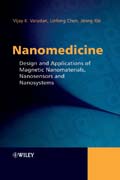
Nanomedicine: design and applications of magnetic nanomaterials, nanosensors and nanosystems
Varadan, Vijay K.
Chen, Linfeng
Xie, Jining
One of the only books designed for novices, researchers, and professionals, Functional Magnetic Nanomaterials for Biomedical Applications provides a comprehensive and systematic analysis of the magnetic properties of various types offunctional materials, including magnetic composites, nanomaterials, and intrinsically smart materials. The authors explore the biomedical applications of each, such as ferrofluids for biomedical diagnoses and therapies, and magnetic biosensors and biochips. INDICE: CONTENTS Preface About the Authors Introduction 1.1 What is nanoscience and nanotechnology 1.2 Magnets and nanometers: mutual attraction 1.3 Typical magnetic nanomaterials 1.4 Nanomedicine and magnetic nanomedicine 1.5 Typical biomedical applications of functional magnetic nanomaterials Physical background for the biomedical applications of functional magnetic nanomaterials 2.1 Requirements for biomedical applications 2.2 Fundamentals of nanomagnetism 2.3 Magnetic relaxation of ferrofluids 2.4 Magnetorheology of ferrofluids 2.5 Manipulation of magnetic particles in fluids 2.6 Interactions between biological nanomaterials and functionalized magnetic nanoparticles Magnetic nanoparticles 3.1 Introduction 3.2 Basics of nanomagnetics 3.3 Synthesis techniques 3.4 Synthesis of magnetic nanoparticles 3.5 Bio-inspired magnetic nanoparticles 3.6 Functionalization of magnetic nanoparticles 3.7 Future prospects Biomedical applications of magnetic nanoparticles 4.1 Introduction 4.2 Diagnostic applications 4.3 Therapeutic applications 4.4 Physiological aspects 4.5 Toxic effectsMagnetosomes and their biomedical applications 5.1 Introduction 5.2 Magnetosome formation 5.3 Cultivation of magnetotactic bacteria 5.4 Characterization ofmagnetosomes 5.5 Biomedical applications of magnetosomes Magnetic nanowires and their biomedical applications 6.1 Introduction 6.2 Magnetism of magnetic nanowires 6.3 Template-based synthesis of magnetic nanowires 6.4 Characterization of magnetic nanowires 6.5 Functionalization of magnetic nanowires 6.6 Magnetic nanowires in suspension 6.7 Biomedical applications of magnetic nanowires Magnetic nanotubes and their biomedical applications 7.1 Introduction 7.2 Magnetism of nanotubes 7.3 Multifunctionality of magnetic nanotubes 7.4 Synthesis and characterization of magnetic nanotubes 7.5 Biomedical applications of magnetic nanotubes Magnetic biosensors 8.1 Introduction 8.2 Magnetoresistance-basedsensors 8.3 Hall effect sensors 8.4 Other sensors detecting stray magnetic fields 8.5 Sensors detecting magnetic relaxations 8.6 Sensors detecting ferrofluid susceptibility Magnetic biochips: basic principles 9.1 Introduction 9.2 Biochips based on giant magnetoresistance sensors 9.3 Biochips based on spin valve sensors 9.4 Biochips based on magnetic tunnel junctions 9.5 Fully integratedbiochips Biomedical applications of magnetic biosensors and biochips 10.1 Introduction 10.2 DNA analysis 10.3 Protein analysis and protein biochips 10.4 Virus detection and cell analysis 10.5 Study of the interactions between biomolecules 10.6 Detection of biological warfare agents 10.7 Environmental monitoring and cleanup 10.8 Outlook Appendix A1. Units for magnetic properties
- ISBN: 978-0-470-03351-7
- Editorial: John Wiley & Sons
- Encuadernacion: Cartoné
- Páginas: 467
- Fecha Publicación: 07/11/2008
- Nº Volúmenes: 1
- Idioma: Inglés
